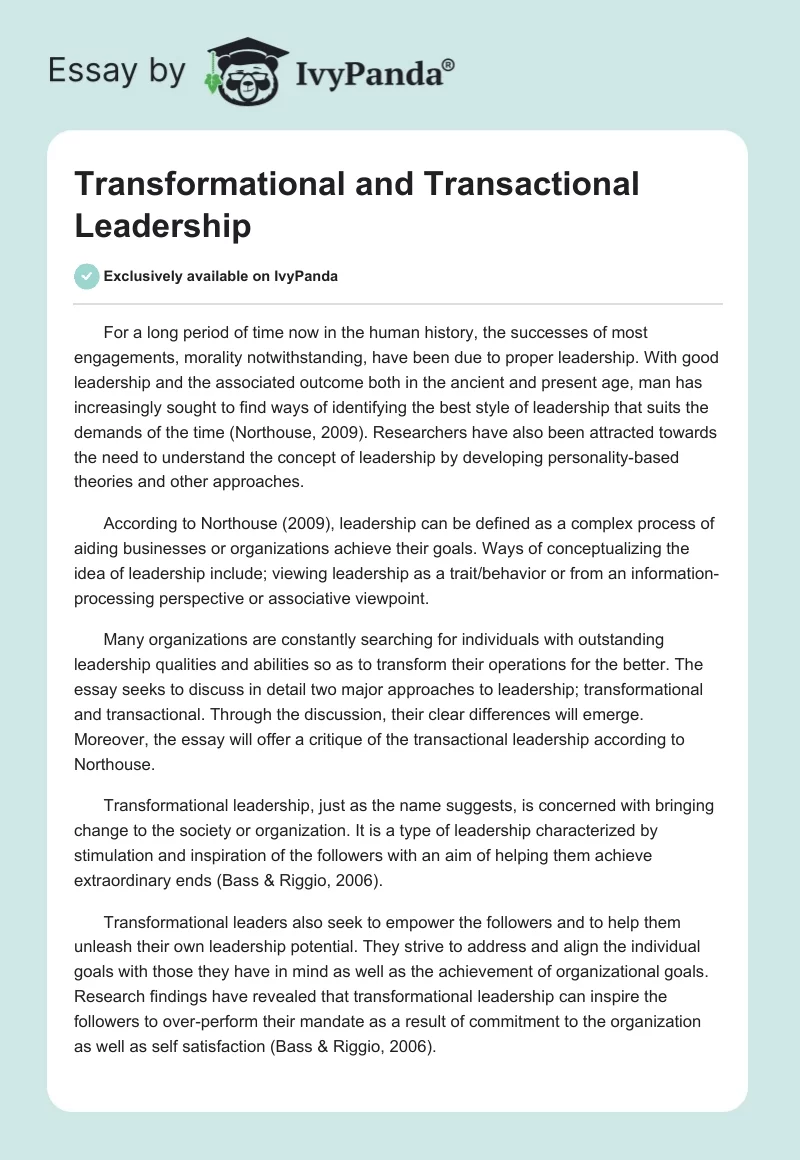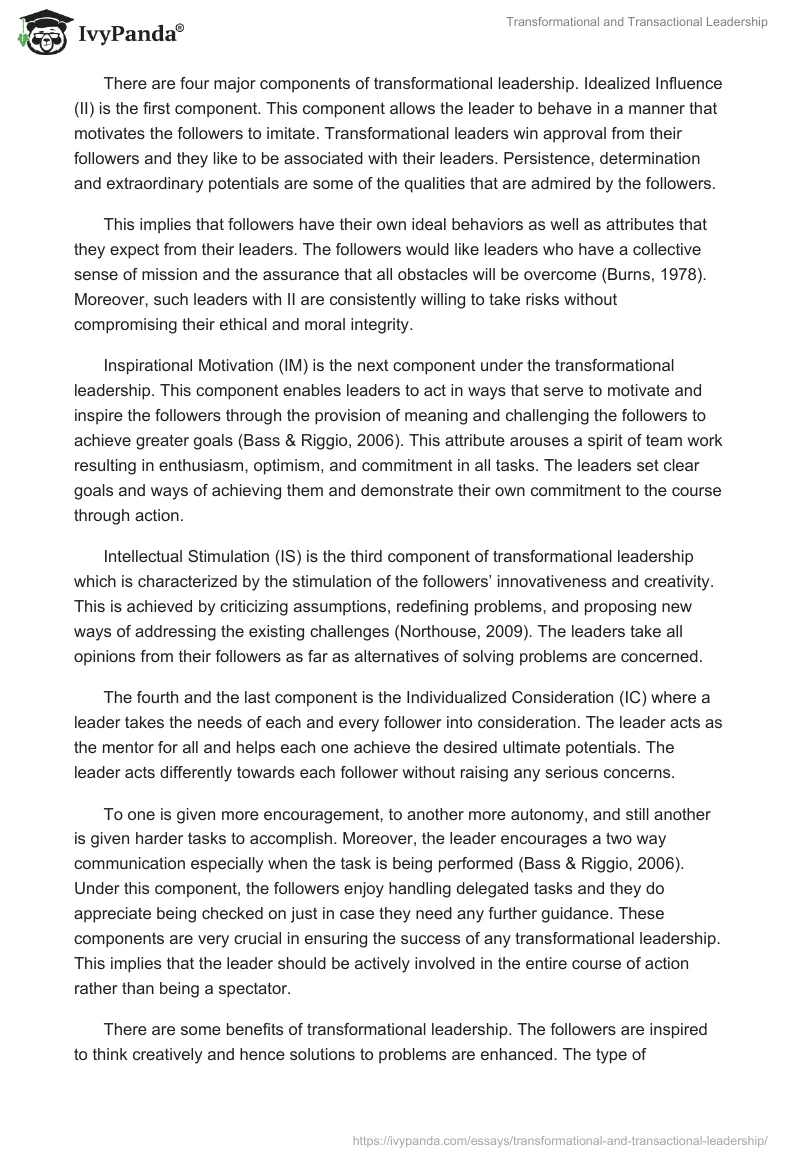For a long period of time now in the human history, the successes of most engagements, morality notwithstanding, have been due to proper leadership. With good leadership and the associated outcome both in the ancient and present age, man has increasingly sought to find ways of identifying the best style of leadership that suits the demands of the time (Northouse, 2009). Researchers have also been attracted towards the need to understand the concept of leadership by developing personality-based theories and other approaches.
According to Northouse (2009), leadership can be defined as a complex process of aiding businesses or organizations achieve their goals. Ways of conceptualizing the idea of leadership include; viewing leadership as a trait/behavior or from an information-processing perspective or associative viewpoint.
Many organizations are constantly searching for individuals with outstanding leadership qualities and abilities so as to transform their operations for the better. The essay seeks to discuss in detail two major approaches to leadership; transformational and transactional. Through the discussion, their clear differences will emerge. Moreover, the essay will offer a critique of the transactional leadership according to Northouse.
Transformational leadership, just as the name suggests, is concerned with bringing change to the society or organization. It is a type of leadership characterized by stimulation and inspiration of the followers with an aim of helping them achieve extraordinary ends (Bass & Riggio, 2006).
Transformational leaders also seek to empower the followers and to help them unleash their own leadership potential. They strive to address and align the individual goals with those they have in mind as well as the achievement of organizational goals. Research findings have revealed that transformational leadership can inspire the followers to over-perform their mandate as a result of commitment to the organization as well as self satisfaction (Bass & Riggio, 2006).
There are four major components of transformational leadership. Idealized Influence (II) is the first component. This component allows the leader to behave in a manner that motivates the followers to imitate. Transformational leaders win approval from their followers and they like to be associated with their leaders. Persistence, determination and extraordinary potentials are some of the qualities that are admired by the followers.
This implies that followers have their own ideal behaviors as well as attributes that they expect from their leaders. The followers would like leaders who have a collective sense of mission and the assurance that all obstacles will be overcome (Burns, 1978). Moreover, such leaders with II are consistently willing to take risks without compromising their ethical and moral integrity.
Inspirational Motivation (IM) is the next component under the transformational leadership. This component enables leaders to act in ways that serve to motivate and inspire the followers through the provision of meaning and challenging the followers to achieve greater goals (Bass & Riggio, 2006). This attribute arouses a spirit of team work resulting in enthusiasm, optimism, and commitment in all tasks. The leaders set clear goals and ways of achieving them and demonstrate their own commitment to the course through action.
Intellectual Stimulation (IS) is the third component of transformational leadership which is characterized by the stimulation of the followers’ innovativeness and creativity. This is achieved by criticizing assumptions, redefining problems, and proposing new ways of addressing the existing challenges (Northouse, 2009). The leaders take all opinions from their followers as far as alternatives of solving problems are concerned.
The fourth and the last component is the Individualized Consideration (IC) where a leader takes the needs of each and every follower into consideration. The leader acts as the mentor for all and helps each one achieve the desired ultimate potentials. The leader acts differently towards each follower without raising any serious concerns.
To one is given more encouragement, to another more autonomy, and still another is given harder tasks to accomplish. Moreover, the leader encourages a two way communication especially when the task is being performed (Bass & Riggio, 2006). Under this component, the followers enjoy handling delegated tasks and they do appreciate being checked on just in case they need any further guidance. These components are very crucial in ensuring the success of any transformational leadership. This implies that the leader should be actively involved in the entire course of action rather than being a spectator.
There are some benefits of transformational leadership. The followers are inspired to think creatively and hence solutions to problems are enhanced. The type of leadership is useful in situations where facts alone may not suffice to bring change. It is also appropriate when employed by managers at the helm of an organization (Northouse, 2009).
However, transformational leadership has some inherent limitations. It is lacking in conceptual clarity in that it involves a ray of many activities hence making it difficult to define. Also, this type of leadership is difficult to measure and the four I’s seem to overlap.
Furthermore, the approach regards leadership as a trait instead of a behavior that anyone can acquire through learning. Finally, transformational leadership can easily be abused especially in propagating immoral behavior like by cults since it involves passionately changing the values and belief systems of the people (Northouse, 2009).
Transactional leadership, on the other hand, is another major approach that has been advanced by researchers. Transactional leaders have been identified as those who lead by embracing social exchange where one thing is given as a result of another. According to Burns (1978), politicians are a good example of transactional leaders since they usually pledge to offer jobs and other opportunities in exchange for votes. Transactional business leaders, on the other hand, offer financial rewards and promotion for the employees who demonstrate high productivity. They may also punish or deny the rewards in case of decreased or lack of productivity (Bass & Riggio, 2006).
There are two major components of this approach to leadership; Contingent Reward (CR) and Management-by-Exception (MBE). Contingent reward is characterized by agreement between the follower and the leader with actual rewards or the promise of a reward upon the successful completion of the assigned task (Bass & Riggio, 2006). Contingent reward can either be transactional if the reward takes a material form or transformational if it is psychological in nature.
Management-by-Exception (MBE), on the other hand, is classified as either active or passive depending on the point of involvement of the leader. Active MBE is characterized by the leader being directly involved in the monitoring of digressions from set standards while the followers are in action.
Passive MBE, on the other hand, is a situation where the leader waits passively until a deviation occurs before corrective measures are taken/proposed (Northouse, 2009). Followers of such leaders are more compliant since they take orders and act the way they are told. This is in contrast with transformational leadership where the followers are allowed to think and act the way they want to at some point.
According to Northouse (2009), this approach has some clear inherent benefits as well as weaknesses as far as leadership is concerned. Most importantly, such leaders are more predictable since the procedure to be used is already laid out. The type of leadership is quite appropriate in middle level management since everything has to be performed according to the policies and procedures, especially in large organizations.
The limitations, on the other hand, include the fact that the followers are neither motivated nor enthusiastic about what they do because they feel they are ordered (Northouse, 2009). Furthermore, leaders treat the followers as people who can be motivated by the promise of a reward.
This exposes the worker to predictability, where the consequences can either be positive or negative. The theory, therefore, ignores the role of other factors like emotions, and ethical values in shaping the followers’ behavior. Another limitation is that it can be effective when used at the helm of organizational management which requires inspiration and clear vision dispensation.
The essay has discussed the transformational and the transactional approaches to leadership. The discussion has brought out the clear differences between the two types of leadership and their respective goals. It has also offered the criticism of transactional leadership according to Northouse, a renowned author. We can therefore conclude that various situations call for the use of the appropriate approaches to leadership.
References
Bass, B. M. & Riggio, R. E. (2006). Transformational leadership (2nd ed.). Routledge
Burns, J. M. (1978). Leadership. Harper & Raw, New York
Northouse, P. G. (2009). Leadership: Theory and practice (5th ed.). SAGE


